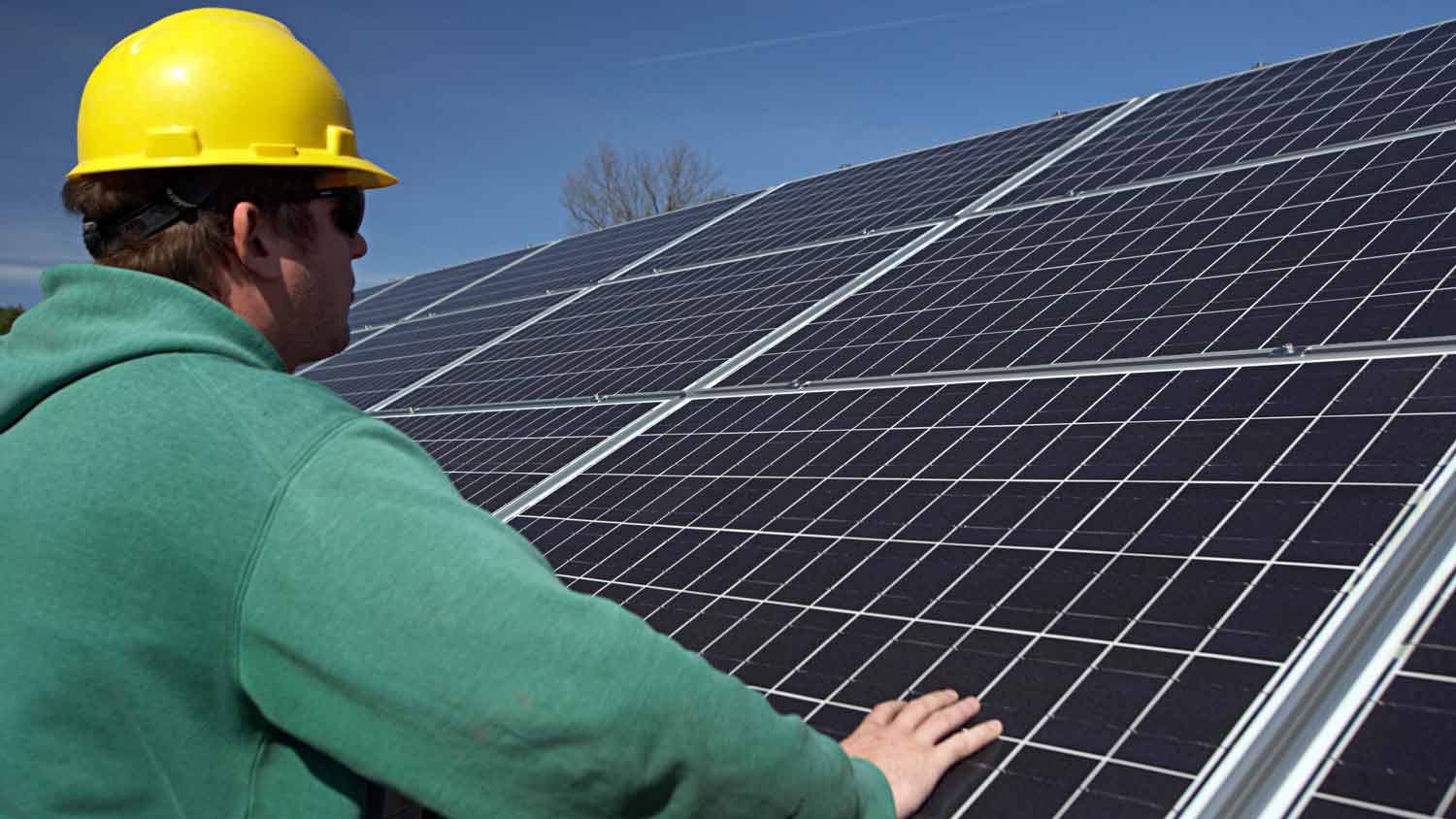
Discover the average solar panel installation cost, key price factors, and expert tips to help you budget for your solar project.
Energy savings and tax breaks make going green a win-win


Home upgrades like solar, geothermal, and wind-powered systems qualify for federal tax credits.
Qualifying energy-efficient systems are eligible for a 30% tax credit.
The tax credit drops to 26% in 2033, 22% in 2034, and ends in 2035.
Energy-efficient upgrades to the home like insulation are also eligible for tax credits.
Investing in solar panels, an environmentally friendly HVAC or electrical system, or other energy-efficient home improvements can save you money in the long run. Still, upfront costs often scare homeowners away from making the switch. However, incentives for solar panels mean that generating your own power with solar doesn’t have to cost an arm and a leg. If you’ve had a new system installed in the past year or plan to do so soon, you may be eligible to reap the benefits of a hefty energy tax credit of up to 30% as well as other solar incentives.
The Residential Clean Energy Credit is a tax credit that can earn homeowners up to 30% of the value of certain solar panel systems and clean energy systems for residential properties. According to the Internal Revenue Service (IRS), if you install certain renewable energy systems in your home that meet their qualifications—including solar panels, geothermal heat pumps, solar water heaters, wind turbines, biomass fuel stoves, or residential fuel cells—you can claim a credit of up to 30% on your tax filing for the year you installed them.
The solar tax credit is a dollar-for-dollar reduction of your federal tax bill. There is no maximum limit, and if the credit you earn is more than the taxes you owe, you can claim unused credits in future years.
The Inflation Reduction Act of 2022 increased the credit amount and extended the life of the program. So now, you have until 2034 to purchase and install your solar system or other renewable energy system. However, the full credit only lasts through 2032. It will drop to 26% in 2033, drop again to 22% in 2034, and will completely disappear in 2035.
Federal Solar Tax Credit Percentage by Year
| 2022–2032 | 2033 | 2034 | 2035 |
|---|---|---|---|
| 30% | 26% | 22% | 0% |
If you’ve got solar on your mind, call a solar panel installer near you and ask them to help you design a system that will save you money now and in the future—including on your taxes with the federal solar tax credit.
To qualify for a 30% federal tax credit, choose products that meet the requirements set by Energy Star. This government-run program is managed by the U.S. Environmental Protection Agency (EPA) and the U.S. Department of Energy (DOE). It helps inform and encourage people to invest in energy-efficient products by offering tax credits as an incentive.
Solar panels qualify for energy-efficiency incentives, but they’re not the only way to claim your credit while shrinking your carbon footprint and lowering your utility bills. Here, we highlight five other Energy Star-approved systems that qualify for federal tax credits. Talk with home energy auditors near you to learn about more ways to save.
Geothermal heat pumps, also called ground-source heat pumps, use ground heat or bodies of water to heat and cool your home, making them one of the best energy-efficient HVAC systems available today. To qualify for a 30% tax credit, your system must be newly installed and Energy Star-certified.
Residential homes that have small wind turbines installed on the property are eligible for up to a 30% tax credit on the turbines and installation. To be considered a small wind turbine, your turbine must not produce more than 100 kW of electricity. Your home does not have to be your primary residence to qualify for this credit.
There are many types of solar energy systems, including solar panels, solar water heaters, solar roofing, and more. All of these solar equipment options are eligible for a 30% tax credit. To qualify, your system needs to generate 50% or more of its energy from the sun.
The system must also be certified by a government-endorsed source, like the Solar Rating and Certification Corporation (SRCC), one of the main leaders in certifying solar heating and cooling products in the U.S. Solar systems that qualify for solar panel incentives can also give you a good ROI if you sell your home.
Fuel cells produce electricity and power your home when you need backup generation. These cells are more efficient than combustion-based products because they only use hydrogen, water, and heat to operate. Investing in a fuel cell system makes you eligible for up to $500 per half kilowatt (kW) of power.
Your fuel cell needs to have at least 0.5 kW electricity capacity and an efficiency rating above 30% to qualify. You also need to have the fuel cell installed in your primary residence.
Multiple people residing in the home can receive individual credits for this type of credit for a maximum of $1,667 per 0.5kW; however, how much you receive depends on how much you claim on the costs paid for the fuel cell and installation.
*Note that married couples who file jointly on their tax returns are only eligible for one credit. If you’re unsure if you qualify, speak with an accountant to determine your eligibility for this type of tax credit.
Biomass fuel stoves use, well, biomass fuel to heat your home or water system. Since biomass fuel consists of crops, trees, wood, plant matter, grass, and other natural materials, it is considered an energy-efficient heating system.
You’ll need to purchase a wood or a pellet stove with a 75% or more thermal efficiency rating to receive the credit, which gets deducted from the total cost of the product and installation. You’ll receive a 30% credit if you install your system before 2032, a 26% credit if you install it in 2033, and a 22% credit if you install it in 2034.
Homeowners will benefit the most from claiming energy-efficient tax credits and incentives for solar panels if they improve their primary residences with qualifying improvements. They can also claim certain tax credits for improvements to their secondary residences or rental properties. Renters aren’t left out, either.
The Inflation Reduction Act of 2022 also expanded potential tax credits to home builders and commercial building owners when they install photovoltaic (PV) solar panels and make other higher-efficiency improvements through the Investment Tax Credit, or ITC.
Whether you’re a homeowner, renter, or business owner, it’s always a smart idea to talk to a trusted tax expert to find out which credits you may qualify for.
Once you’ve made a purchase that qualifies you for a residential tax credit, you’ll need to refer to the IRS and follow the instructions to apply for the credit. The form for filing for the tax credit is IRS Form 5695.
If you have any questions regarding the filing process, speak with a financial professional or accountant near you to help you file for the tax credit.
You can find the energy credits under Form 5695, which is labeled as a “Nonbusiness Energy Property Credit.” Your tax credit will occur as a dollar-for-dollar reduction on how much income tax you owe during the tax year.
For instance, if your federal tax return says that you owe $500, but your energy efficiency tax credit totaled $250, then the IRS will reduce the amount you owe to $250.

In addition to energy-efficient products and services, other types of energy efficiency improvements are eligible for tax credits. These include:
Insulation: You can receive 30% off insulation costs up to $1,200, including the installation. Insulation credits include weatherstripping, spray foam sealants, caulking, and house wraps.
Metal and asphalt roofs: Energy Star-certified roofs with a pigmented coating or cooling granules for heat reduction are eligible for 10% off your purchase up to $500. This does not include installation costs. Roof replacements that include solar and other efficient roofing upgrades may also qualify.
Windows, doors, and skylights: Receive 30% off Energy Star-certified windows, doors, and skylights for a maximum of $600. These products must be a new installation, and the tax credit doesn’t count towards the installation costs.
You can claim federal solar tax credits, including the Residential Clean Energy Credit and the ITC, alongside other incentives for solar panels and similar renewable energy systems. That includes state rebates, renewable energy certificates, and manufacturer rebates. However, be aware that other incentives can lower the credit amount if they lower the cost of the installation.
For example, utility rebates and manufacturer rebates will lower your overall system costs, so when you calculate your tax credit, the amount you paid out will be lower than the sticker price. Additionally, if you receive venerable energy certificate payments, that can be considered taxable income, which can increase your federal taxes.
Talk with your accountant or tax preparer to fully understand how solar tax credits and other incentives impact each other and your overall tax liability.
From average costs to expert advice, get all the answers you need to get your job done.

Discover the average solar panel installation cost, key price factors, and expert tips to help you budget for your solar project.

Solar battery costs depend on the size of your system, labor, and capacity. Learn how much you could pay for batteries for home solar systems.

There are a few factors to consider when it comes to solar panel repair costs. This guide breaks down the prices of solar panel removal, repair, and replacement.

How do solar panels work and what exactly do they do? Learn all about solar power generation to decide if it’s the right decision for your home.

Want to run your solar system without a battery? Here are the pros and cons, as well as what you need to know about how to use a solar panel directly without batteries.

Find out how much it costs to remove solar panels, including average prices, key cost factors, and tips to save money on your solar panel removal project.